light NISSAN PULSAR 1987 Repair Manual
[x] Cancel search | Manufacturer: NISSAN, Model Year: 1987, Model line: PULSAR, Model: NISSAN PULSAR 1987Pages: 238, PDF Size: 28.91 MB
Page 170 of 238
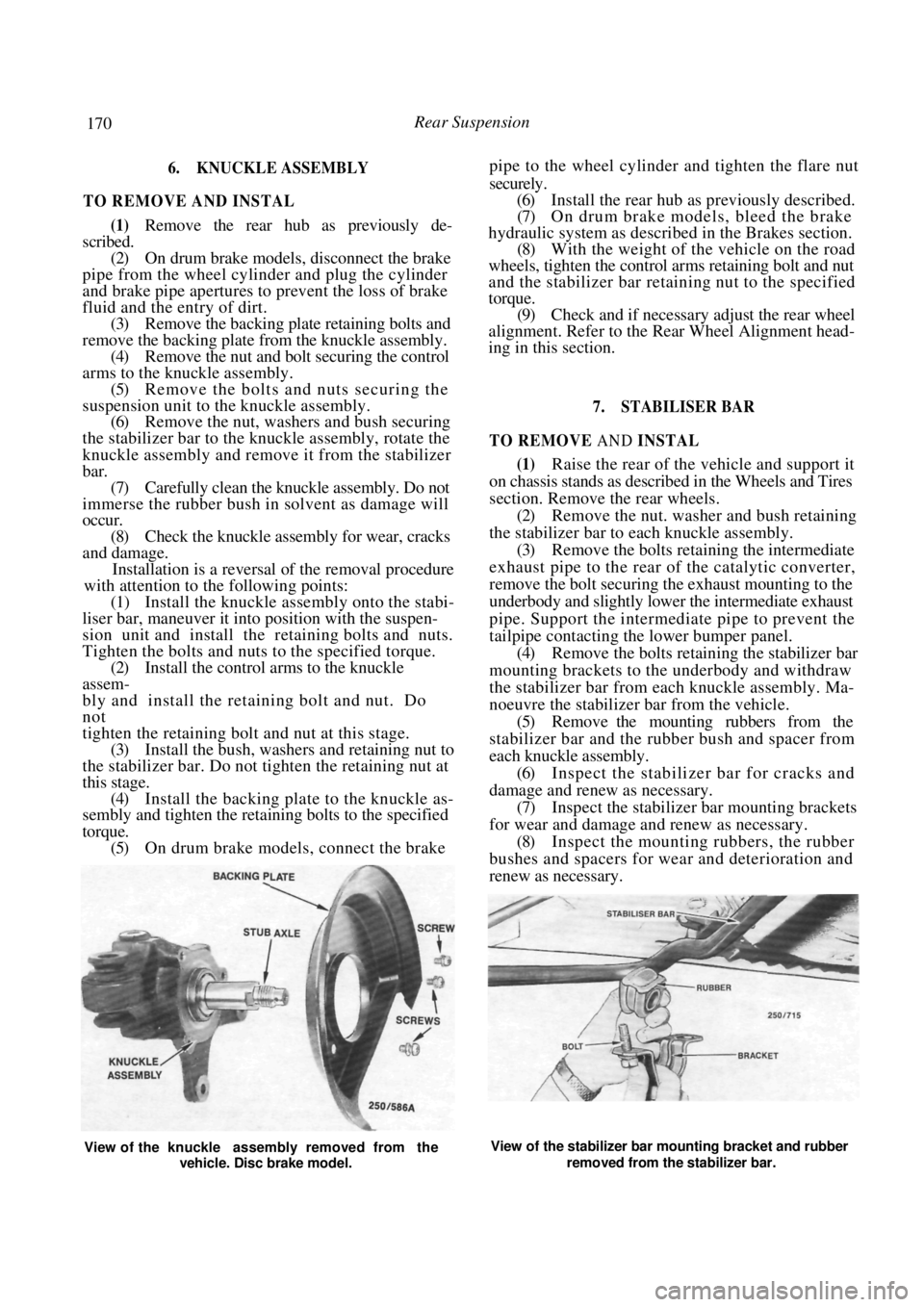
170 Rear Suspension
6. KNUCKLE ASSEMBLY
TO REMOVE AND INSTAL
(1) Remove the rear hub as previously de-
scribed.
(2) On drum brake models, disconnect the brake
pipe from the wheel cylinder and plug the cylinder
and brake pipe apertures to prevent the loss of brake
fluid and the entry of dirt. (3) Remove the backing plate retaining bolts and
remove the backing plate from the knuckle assembly. (4) Remove the nut and bolt securing the control
arms to the knuckle assembly. (5) Remove the bolts and nuts securing the
suspension unit to the knuckle assembly. (6) Remove the nut, washers and bush securing
the stabilizer bar to the knuckle assembly, rotate the
knuckle assembly and remove it from the stabilizer
bar. (7) Carefully clean the knuckle assembly. Do not
immerse the rubber bush in solvent as damage will
occur.
(8) Check the knuckle assembly for wear, cracks
and damage. Installation is a reversal of the removal procedure
with attention to the following points:
(1) Install the knuckle assembly onto the stabi-
liser bar, maneuver it into position with the suspen-
sion unit and install the retaining bolts and nuts.
Tighten the bolts and nuts to the specified torque.
(2) Install the control arms to the knuckle
assem-
bly and install the retaining bolt and nut. Do
not
tighten the retaining bolt and nut at this stage. (3) Install the bush, washers and retaining nut to
the stabilizer bar. Do not tighten the retaining nut at
this stage. (4) Install the backing plate to the knuckle as-
sembly and tighten the retaining bolts to the specified
torque.
(5) On drum brake models, connect the brake
pipe to the wheel cylinder and tighten the flare nut
securely.
(6) Install the rear hub as previously described.
(7) On drum brake models, bleed the brake
hydraulic system as described in the Brakes section.
(8) With the weight of the vehicle on the road
wheels, tighten the control arms retaining bolt and nut
and the stabilizer bar retaining nut to the specified
torque. (9) Check and if necessary adjust the rear wheel
alignment. Refer to the Re ar Wheel Alignment head-
ing in this section.
7. STABILISER BAR
TO REMOVE AND INSTAL
(1) Raise the rear of the vehicle and support it
on chassis stands as describe d in the Wheels and Tires
section. Remove the rear wheels.
(2) Remove the nut. washer and bush retaining
the stabilizer bar to each knuckle assembly. (3) Remove the bolts retain ing the intermediate
exhaust pipe to the rear of the catalytic converter,
remove the bolt securing the exhaust mounting to the
underbody and slightly lower the intermediate exhaust
pipe. Support the intermediate pipe to prevent the
tailpipe contacting the lower bumper panel. (4) Remove the bolts retaining the stabilizer bar
mounting brackets to the underbody and withdraw
the stabilizer ba r from each knuckle assembly. Ma-
noeuvre the stabilizer bar from the vehicle.
(5) Remove the mounting rubbers from the
stabilizer bar and the rubber bush and spacer from
each knuckle assembly. (6) Inspect the stabilizer bar for cracks and
damage and renew as necessary. (7) Inspect the stabilizer bar mounting brackets
for wear and damage and renew as necessary. (8) Inspect the mounting rubbers, the rubber
bushes and spacers for wear and deterioration and
renew as necessary.
View of the knuckle assembly removed from the
vehicle. Disc brake model. View of the stabilizer bar mounting bracket and rubber
removed from the stabilizer bar.
Page 172 of 238

172
BRAKES
SPECIFICATIONS
Type:
Except Pulsar/Vector GL from
July 1989 and Astra models ... Four wheel disc
Pulsar/Vector GL from
July 1989 and Astra models —
Front...............................................................Disc
Rear..............................................................Drum
Operation:
Footbrake ............... Vacuum assisted diagonally
split dual hydraulic
Handbrake................ Mechanical on rear wheels
Fluid type ...........................................................Dot 4
Master cylinder:
Make ........................................................ Girlock
Bore diameter —
Large .................................................... 25.40 mm
Small .................................................... 20.64 mm
Front disc brakes:
Caliper bore diameter ........................... 48.1 mm
Disc diameter ........................................ 240 mm
Disc thickness, minimum ......................... 16 mm
Disc runout, maximum ......................... 0.07 mm
Disc pad thickness, minimum ....................2 mm
Rear disc pads:
Caliper bore diameter ......................... 30.16 mm
Disc diameter ........................................ 234 mm
Disc thickness, minimum ...........................9 mm
Disc runout, maximum .......................... 0.07 mm
Disc pad thickness, minimum ....................2 mm
Rear drum brakes:
Wheel cylinder bore diameter ............ 15.87 mm
Drum diameter, maximum ............... 204.50 mm
Drum out of round, maximum.............. 0.03 mm
Drum runout, maximum ........................ 0.05 mm
Brake lining wear limit ........................... 1.5 mm
TORQUE WRENCH SETTINGS
Brake pedal bracket to body........................... 11 Nm
Brake pedal pivot bolt ..................................... 11 Nm
Brake servo unit to body................................. I I N m
Brake servo unit to master cylinder ............... 11 Nm
Pressure differential piston plug ...................... 12 Nm
Proportioning valve plug................................. 27 Nm
Caliper anchor plate bolts ............................... 52 Nm
Caliper guide bolts .......................................... 31 Nm
Brake hose to caliper....................................... 34 Nm
Handbrake cable bracket bolt ......................... 49 Nm
Handbrake lever to body ................................ 11 Nm
Cable clamp to body....................................... 11 Nm
Cam lever nut.................................................. 49 Nm
1. BRAKES TROUBLE SHOOTING
BRAKE PEDAL HARD
(1) Seized caliper piston or wheel cylinder: Over-
haul the caliper or wheel cylinder.
(2) Seized master cylinder piston: Overhaul the
master cylinder. (3) Seized pedal pivot: Rectify or renew the
pedal pivot shaft and bushes. (4) Restricted brake line: Remove the restriction
or renew the brake line.
(5) Vacuum servo system inoperative: Check
and repair the servo system.
NOTE: The vacuum servo system can be
checked as follows: With the engine
switched off, pump the brake pedal several
times to deplete any vacuum in the system.
With the engine still switched off, press
down firmly on the brake pedal and hold it
there noting the position and pressure re-
quired. Start the engine. If the servo unit is
operating correctly, the brake pedal will sink
slightly and the pressure required to hold it
may reduce. If the pedal does not sink
slightly when the engine is started, check the
vacuum supply to the servo unit. If vacuum
is reaching the brake servo unit, the unit can
be considered inoperative.
BRAKE DRAG
(1) Clogged master cylinder ports: Clean the
master cylinder and the fluid reservoir. Renew the
brake fluid. (2) Seized caliper piston or wheel cylinder: Over-
haul the caliper or wheel cylinder.
(3) Seized handbrake linkage: Free up or renew
the linkage.
Page 173 of 238
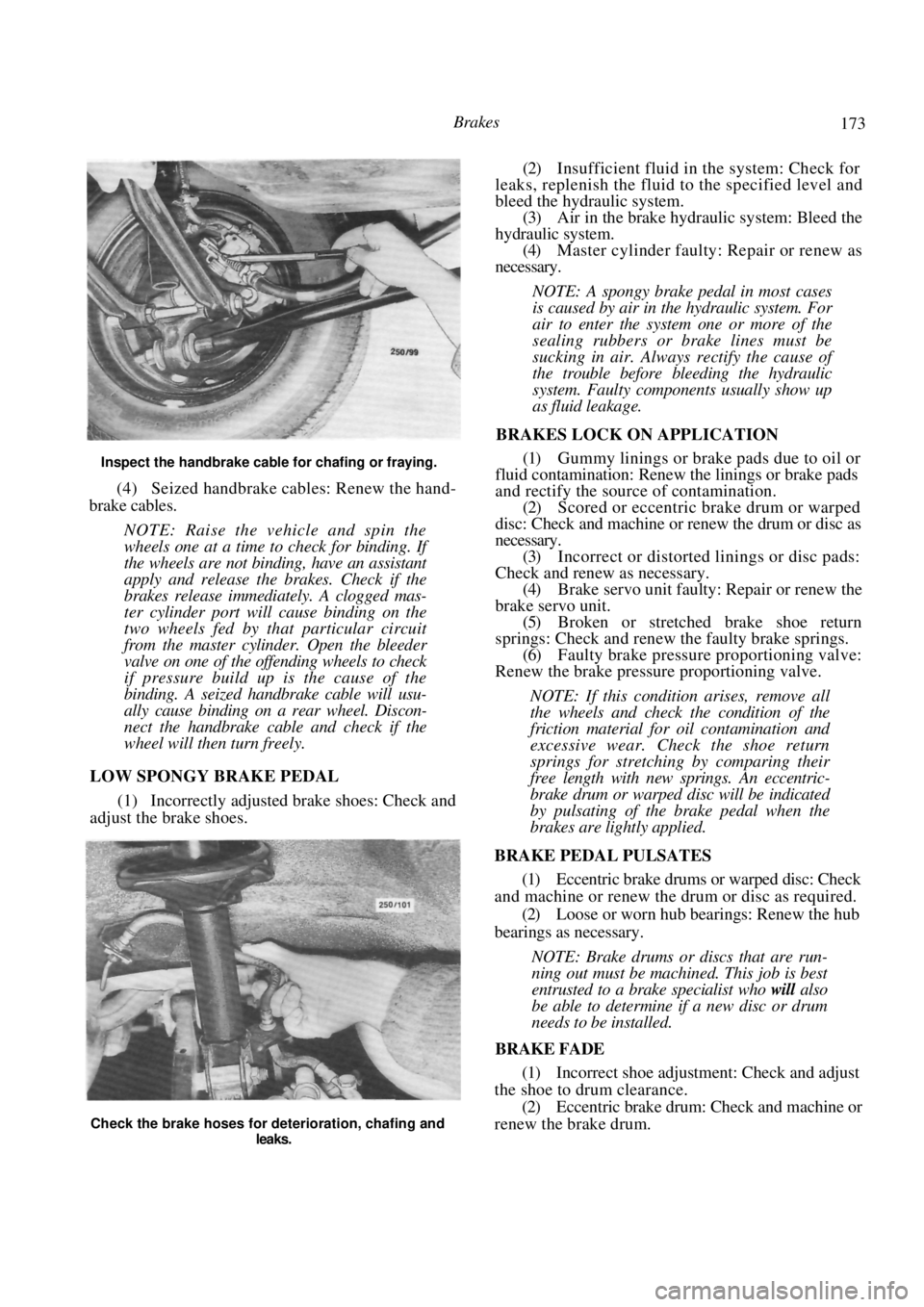
Brakes 173
Inspect the handbrake cable for chafing or fraying.
(4) Seized handbrake cables: Renew the hand-
brake cables.
NOTE: Raise the vehicle and spin the
wheels one at a time to check for binding. If
the wheels are not binding, have an assistant
apply and release the brakes. Check if the
brakes release immediately. A clogged mas-
ter cylinder port will cause binding on the
two wheels fed by that particular circuit
from the master cylinder. Open the bleeder
valve on one of the o ffending wheels to check
if pressure build up is the cause of the
binding. A seized handbrake cable will usu-
ally cause binding on a rear wheel. Discon-
nect the handbrake cable and check if the
wheel will then turn freely.
LOW SPONGY BRAKE PEDAL
(1) Incorrectly adjusted brake shoes: Check and
adjust the brake shoes.
(2) Insufficient fluid in the system: Check for
leaks, replenish the fluid to the specified level and
bleed the hydraulic system.
(3) Air in the brake hydraulic system: Bleed the
hydraulic system. (4) Master cylinder faulty: Repair or renew as
necessary.
NOTE: A spongy brake pedal in most cases
is caused by air in the hydraulic system. For
air to enter the system one or more of the
sealing rubbers or brake lines must be
sucking in air. Always rectify the cause of
the trouble before bleeding the hydraulic
system. Faulty components usually show up
as fluid leakage.
BRAKES LOCK ON APPLICATION
(1) Gummy linings or brake pads due to oil or
fluid contamination: Renew the linings or brake pads
and rectify the source of contamination. (2) Scored or eccentric brake drum or warped
disc: Check and machine or renew the drum or disc as
necessary.
(3) Incorrect or distorted linings or disc pads:
Check and renew as necessary. (4) Brake servo unit faulty: Repair or renew the
brake servo unit. (5) Broken or stretched brake shoe return
springs: Check and renew th e faulty brake springs.
(6) Faulty brake pressure proportioning valve:
Renew the brake pressure proportioning valve.
NOTE: If this condition arises, remove all
the wheels and check the condition of the
friction material for oil contamination and
excessive wear. Check the shoe return
springs for stretching by comparing their
free length with new sp rings. An eccentric-
brake drum or warped disc will be indicated
by pulsating of the brake pedal when the
brakes are lightly applied.
BRAKE PEDAL PULSATES
(1) Eccentric brake drums or warped disc: Check
and machine or renew the drum or disc as required.
(2) Loose or worn hub bearings: Renew the hub
bearings as necessary.
NOTE: Brake drums or discs that are run-
ning out must be machined. This job is best
entrusted to a brake specialist who will also
be able to determine if a new disc or drum
needs to be installed.
BRAKE FADE
(1) Incorrect shoe adjustment: Check and adjust
the shoe to drum clearance. (2) Eccentric brake drum: Check and machine or
renew the brake drum.
Check the brake hoses for deterioration, chafing and
leaks.
Page 175 of 238
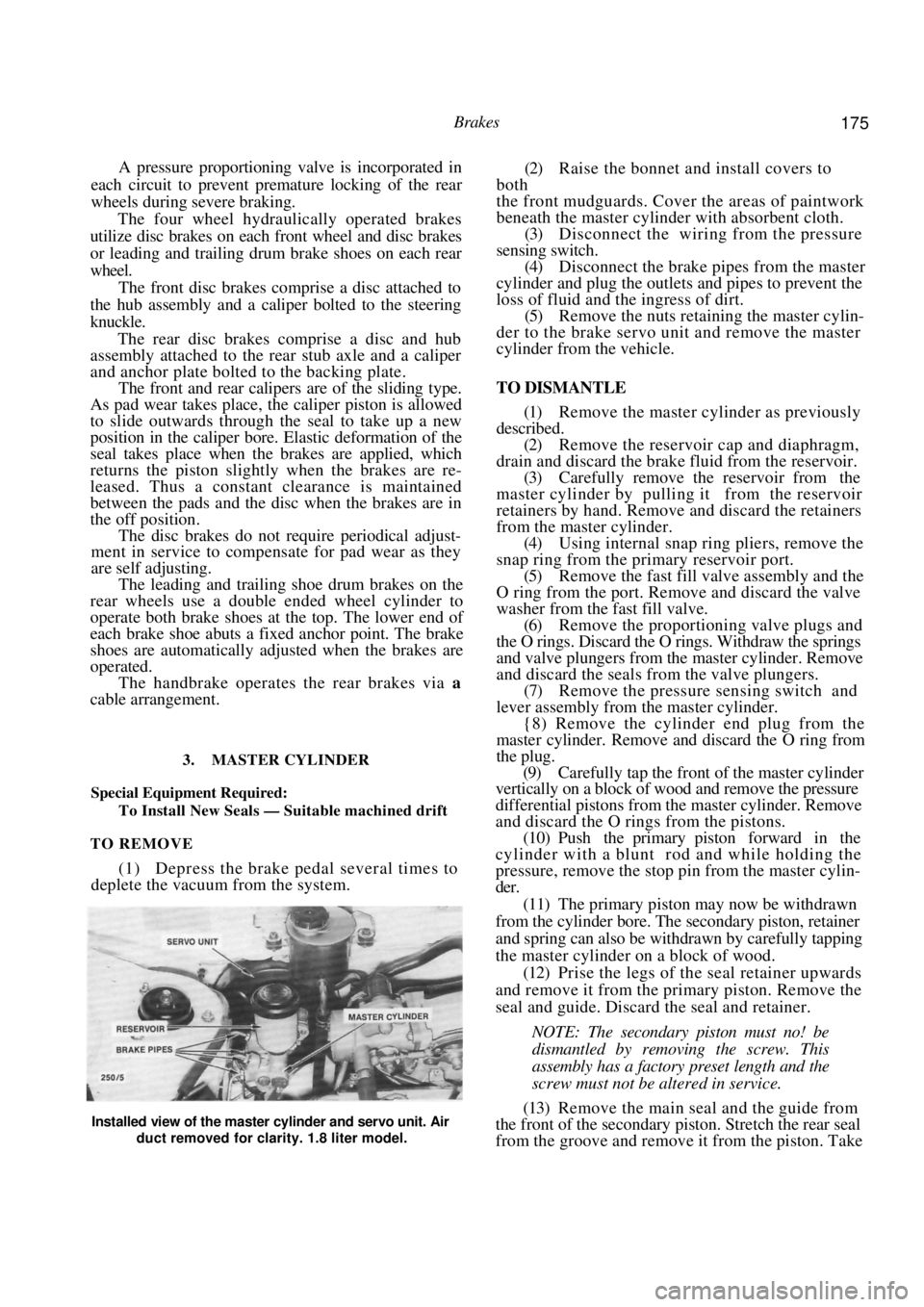
Brakes 175
A pressure proportioning valve is incorporated in
each circuit to prevent premature locking of the rear
wheels during severe braking.
The four wheel hydraulically operated brakes
utilize disc brakes on each front wheel and disc brakes
or leading and trailing drum brake shoes on each rear
wheel.
The front disc brakes comprise a disc attached to
the hub assembly and a caliper bolted to the steering
knuckle.
The rear disc brakes comprise a disc and hub
assembly attached to the rear stub axle and a caliper
and anchor plate bolted to the backing plate.
The front and rear calipers are of the sliding type.
As pad wear takes place, the caliper piston is allowed
to slide outwards through the seal to take up a new
position in the caliper bore. Elastic deformation of the
seal takes place when the brakes are applied, which
returns the piston slightly when the brakes are re-
leased. Thus a constant clearance is maintained
between the pads and the disc when the brakes are in
the off position.
The disc brakes do not require periodical adjust-
ment in service to compensate for pad wear as they
are self adjusting.
The leading and trailing shoe drum brakes on the
rear wheels use a double ended wheel cylinder to
operate both brake shoes at the top. The lower end of
each brake shoe abuts a fixed anchor point. The brake
shoes are automatically adju sted when the brakes are
operated.
The handbrake operates the rear brakes via a
cable arrangement.
3. MASTER CYLINDER
Special Equipment Required:
To Install New Seals — Suitable machined drift
TO REMOVE
(1) Depress the brake pedal several times to
deplete the vacuum from the system.
(2) Raise the bonnet and install covers to
both
the front mudguards. Cover the areas of paintwork
beneath the master cylinder with absorbent cloth.
(3) Disconnect the wiring from the pressure
sensing switch. (4) Disconnect the brake pipes from the master
cylinder and plug the outlets and pipes to prevent the
loss of fluid and the ingress of dirt.
(5) Remove the nuts retaining the master cylin-
der to the brake servo unit and remove the master
cylinder from the vehicle.
TO DISMANTLE
(1) Remove the master cylinder as previously
described. (2) Remove the reservoir cap and diaphragm,
drain and discard the brake fluid from the reservoir. (3) Carefully remove the reservoir from the
master cylinder by pulling it from the reservoir
retainers by hand. Remove and discard the retainers
from the master cylinder. (4) Using internal snap ring pliers, remove the
snap ring from the primary reservoir port. (5) Remove the fast fill valve assembly and the
O ring from the port. Remove and discard the valve
washer from the fast fill valve.
(6) Remove the proportioning valve plugs and
the O rings. Discard the O rings. Withdraw the springs
and valve plungers from the master cylinder. Remove
and discard the seals from the valve plungers. (7) Remove the pressure sensing switch and
lever assembly from the master cylinder. {8) Remove the cylinder end plug from the
master cylinder. Remove and discard the O ring from
the plug.
(9) Carefully tap the front of the master cylinder
vertically on a block of wo od and remove the pressure
differential pistons from the master cylinder. Remove
and discard the O rings from the pistons. (10) Push the primary piston forward in the
cylinder with a blunt rod and while holding the
pressure, remove the stop pin from the master cylin-
der.
(11) The primary piston may now be withdrawn
from the cylinder bore. The secondary piston, retainer
and spring can also be withdrawn by carefully tapping
the master cylinder on a block of wood. (12) Prise the legs of the seal retainer upwards
and remove it from the primary piston. Remove the
seal and guide. Discard the seal and retainer.
NOTE: The secondary piston must no! be
dismantled by removing the screw. This
assembly has a factory p reset length and the
screw must not be altered in service.
(13) Remove the main seal and the guide from
the front of the secondary piston. Stretch the rear seal
from the groove and remove it from the piston. Take
Installed view of the master cylinder and servo unit. Air
duct removed for clarity. 1.8 liter model.
Page 176 of 238
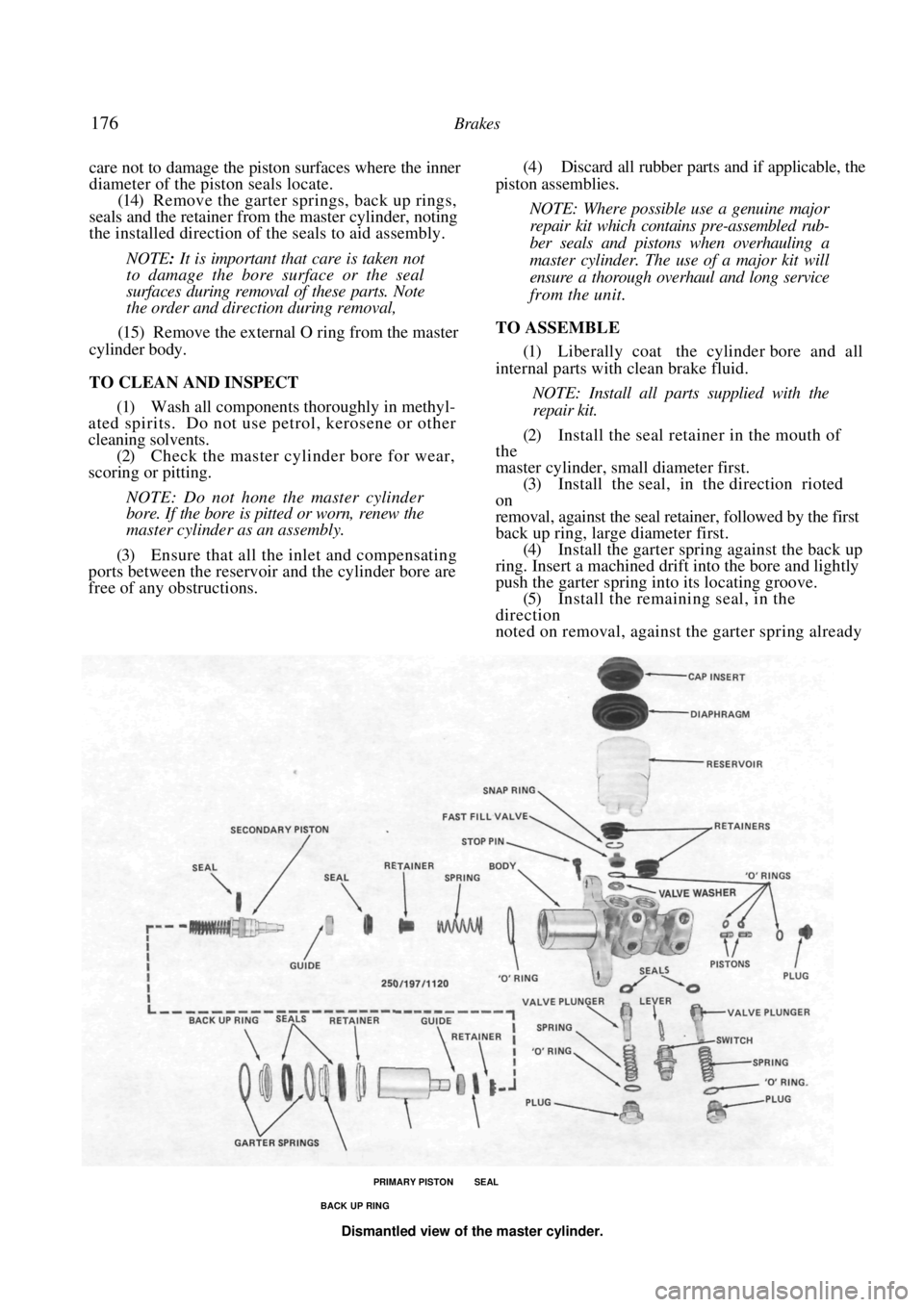
176 Brakes
care not to damage the piston surfaces where the inner
diameter of the piston seals locate.
(14) Remove the garter springs, back up rings,
seals and the retainer from the master cylinder, noting
the installed direction of the seals to aid assembly.
NOTE: It is important that care is taken not
to damage the bore surface or the seal
surfaces during removal of these parts. Note
the order and direction during removal,
(15) Remove the external O ring from the master
cylinder body.
TO CLEAN AND INSPECT
(1) Wash all components thoroughly in methyl-
ated spirits. Do not use petrol, kerosene or other
cleaning solvents. (2) Check the master cyli nder bore for wear,
scoring or pitting.
NOTE: Do not hone the master cylinder
bore. If the bore is pitted or worn, renew the
master cylinder as an assembly.
(3) Ensure that all the inlet and compensating
ports between the reservoir and the cylinder bore are
free of any obstructions.
(4) Discard all rubber parts and if applicable, the
piston assemblies.
NOTE: Where possible use a genuine major
repair kit which contains pre-assembled rub-
ber seals and pistons when overhauling a
master cylinder. The use of a major kit will
ensure a thorough overhaul and long service
from the unit.
TO ASSEMBLE
(1) Liberally coat the cylinder bore and all
internal parts with clean brake fluid.
NOTE: Install all parts supplied with the
repair kit.
(2) Install the seal retainer in the mouth of
the
master cylinder, small diameter first.
(3) Install the seal, in the direction rioted
on
removal, against the seal retainer, followed by the first
back up ring, large diameter first. (4) Install the garter spring against the back up
ring. Insert a machined drift into the bore and lightly
push the garter spring into its locating groove. (5) Install the remaining seal, in the
direction
noted on removal, against the garter spring already
PRIMARY PISTON SEAL
BACK UP RING
Dismantled view of the master cylinder.
Page 177 of 238

Brakes 177
installed. Install the second back up ring, large
diam-
eter first.
(6) Install the second garter spring. Insert
a
machined drift into the bore and lightly push the
garter spring into its locating groove.
(7) Smear the secondary piston with clean brake
fluid. Ease the seal over the piston body into the
groove adjacent to the spring, ensuring that the seal lip
faces the spring and that the nylon spacer is against
the back of the seal. (8) Install the guide onto the secondary
piston,
large internal diameter first, followed by the main seal
with the lip facing away from the spring. (9) Lubricate the secondary piston assembly
with clean brake fluid and install the secondary spring
and retainer to the piston. Install the complete assem-
bly into the master cylinder bore. (10) Smear the primary piston with clean brake
fluid. Install the guide, large internal diameter first,
followed by the main seal with the lip facing towards
the small end of the piston.
(11) Install the retainer to the spigot on the front
end of the primary piston ensuring that the legs of the
retainer engage with the groove on the piston. (12) Lubricate the primary piston assembly with
clean brake fluid and install the assembly into the
master cylinder bore. With a blunt rod, push the
assembly down the bore sufficiently to preload the
pistons. While holding the preload, install the stop pin
and valve assemblies into
the master cylinder body and tighten securely. (13) Install a new O ring to the groove on the boss
of the mounting flange of the master cylinder.
(14) Install new O rings to th e pressure differential
pistons, smear them with cl ean brake fluid and install
them into the master cylinder body. (15) Install a new O ring to the pressure differen-
tial end plug, install the plug to the master
cylinder
body and tighten to the specified torque. (16) Using a blunt probe entered through the
sensing switch location hole, separate the pressure
differential pistons and install the switch actuating
lever between them. (17) Screw the sensing switch into its locating
hole until the detents on the switch body just contact
the locating hole facing (w ith the radial grooves).
Screw the switch assembly in a further half to one full
turn ensuring that the dete nts locate in the grooves.
(18) Install new valve seal s to the proportioning
valve plungers, with the serrations of the seals facing
away from the hexagons of the plungers.
(19) Install the new O rings to the
proportioning
valve plugs. (20) Install the valve springs over the stems of the
proportioning valves, insert the install the valve
plugs.
Tighten the plugs to the specified torque.
(21) Install a new O ring to the base of the fast fill
valve assembly. Install a new valve washer to the base
of the valve.
(22) Install the fast fill valve assembly in
the
primary reservoir port (nearest to the mounting flange
of the master cylinder) and install the snap ring
to
retain the assembly. Ensure that the snap ring is
correctly seated in the groove. (23) Smear the new reservoir retainers with clean
brake fluid and install them into the reservoir ports.
Carefully press the brake fluid reservoir into position,
ensuring that the outlet extensions are fully inserted in
the reservoir retainers. (24) Install the reservoir cap insert to the dia-
phragm and press the cap assembly onto the reservoir.
TO INSTAL
Installation is a reversal of the removal procedure
with attention to the following points:
(1) Pour a small amount of clean brake fluid into
the reservoir and pump the master cylinder pistons
with a blunt rod until fluid begins to emerge from the
outlets. (2) Install the master cylinder to the brake servo
unit and loosely install the master cylinder retaining
nuts. (3) Connect the brake pipes to the master cylin-
der outlets, but do not tighten at this stage. (4) Securely tighten the nuts retaining the master
cylinder to the brake servo unit.
(5) Securely tighten the brake pipes and connect
the wiring to the pressure sensing switch.
(6) Fill the master cylinder reservoir with clean
brake fluid and bleed the brakes as described under
the Hydraulic System heading. (7) Check and if necessary adjust the brake
pedal height and free play as described under the
Brake Pedal heading.
4. BRAKE SERVO UNIT
TO CHECK OPERATION
(1) With the engine switched off, apply the
footbrake several times to exhaust all vacuum from
the system.
(2) Apply the footbrake and hold the brake pedal
fully depressed.
(3) Start the engine. If the servo unit is function-
ing satisfactorily a distinct downward movement of
the
brake pedal should be noticed. Should the pedal fail to move downward when the
engine has been started, the vacuum system can be
considered inoperative.
NOTE: If the pedal continues to fall away
there is a fault in the hydraulic system.
(4) Ensure that the brake pedal is fully released,
start the engine and run it at medium speed. Stop the
engine.
Page 180 of 238
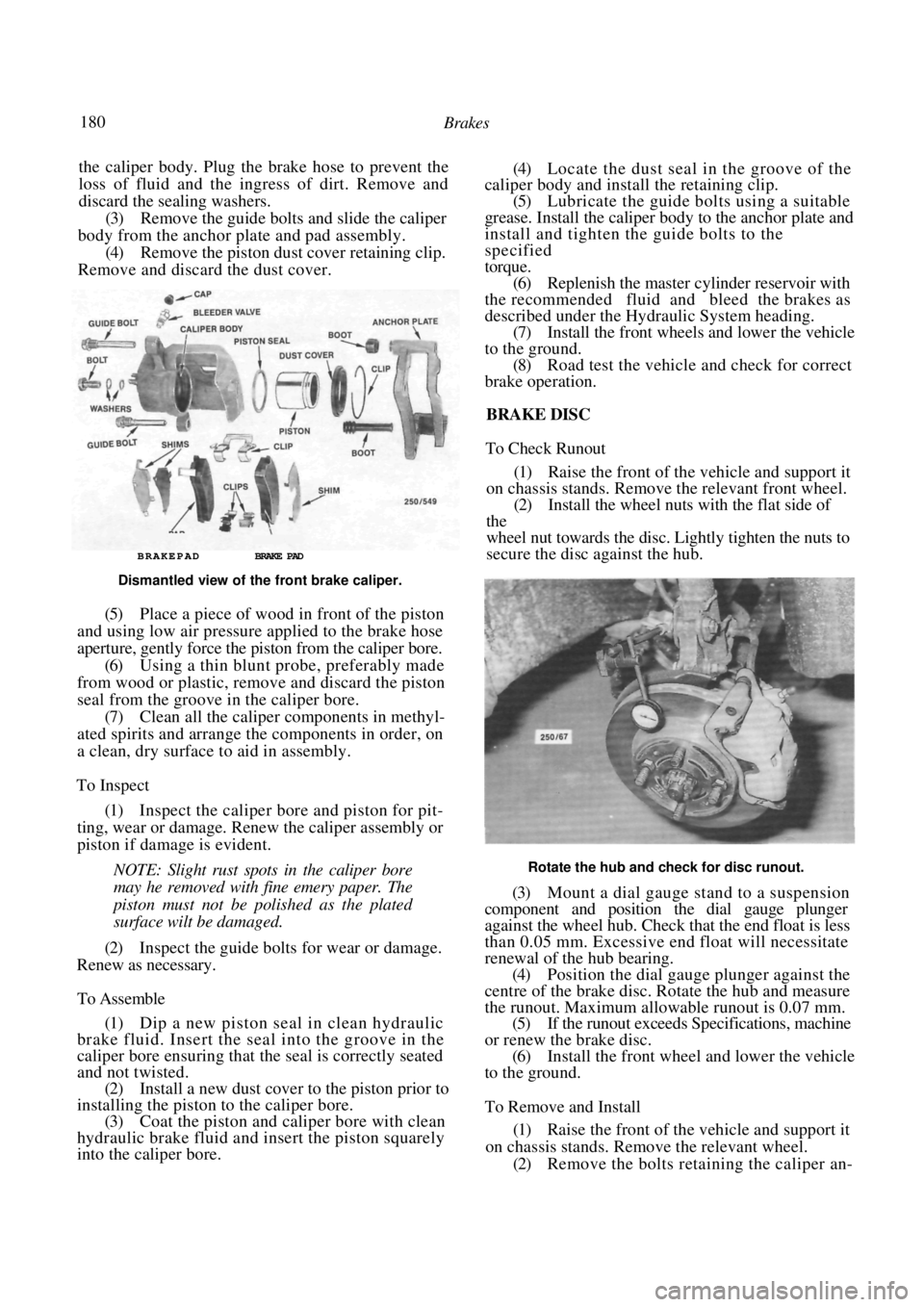
180 Brakes
the caliper body. Plug the brake hose to prevent the
loss of fluid and the ingress of dirt. Remove and
discard the sealing washers.
(3) Remove the guide bolts and slide the caliper
body from the anchor plate and pad assembly. (4) Remove the piston dust cover retaining clip.
Remove and discard the dust cover.
BRAKEPAD BRAKE PAD
Dismantled view of the front brake caliper.
(5) Place a piece of wood in front of the piston
and using low air pressure applied to the brake hose
aperture, gently force the piston from the caliper bore.
(6) Using a thin blunt probe, preferably made
from wood or plastic, remove and discard the piston
seal from the groove in the caliper bore. (7) Clean all the caliper components in methyl-
ated spirits and arrange the components in order, on
a clean, dry surface to aid in assembly.
To Inspect
(1) Inspect the caliper bore and piston for pit-
ting, wear or damage. Renew the caliper assembly or
piston if damage is evident.
NOTE: Slight rust spots in the caliper bore
may he removed with fine emery paper. The
piston must not be polished as the plated
surface wilt be damaged.
(2) Inspect the guide bolts for wear or damage.
Renew as necessary.
To Assemble
(1) Dip a new piston seal in clean hydraulic
brake fluid. Insert the seal into the groove in the
caliper bore ensuring that the seal is correctly seated
and not twisted.
(2) Install a new dust cover to the piston prior to
installing the piston to the caliper bore. (3) Coat the piston and caliper bore with clean
hydraulic brake fluid and insert the piston squarely
into the caliper bore.
(4) Locate the dust seal in the groove of the
caliper body and install the retaining clip.
(5) Lubricate the guide bolts using a suitable
grease. Install the caliper body to the anchor plate and
install and tighten the guide bolts to the
specified
torque. (6) Replenish the master cylinder reservoir with
the recommended fluid and bleed the brakes as
described under the Hydr aulic System heading.
(7) Install the front wheels and lower the vehicle
to the ground. (8) Road test the vehicle and check for correct
brake operation.
BRAKE DISC
To Check Runout
(1) Raise the front of the vehicle and support it
on chassis stands. Remove the relevant front wheel. (2) Install the wheel nuts with the flat side of
the
wheel nut towards the disc. Lightly tighten the nuts to
secure the disc against the hub.
Rotate the hub and check for disc runout.
(3) Mount a dial gauge stand to a suspension
component and position the dial gauge plunger
against the wheel hub. Check that the end float is less
than 0.05 mm. Excessive e nd float will necessitate
renewal of the hub bearing. (4) Position the dial gauge plunger against the
centre of the brake disc. Ro tate the hub and measure
the runout. Maximum allowable runout is 0.07 mm. (5) If the runout exceeds Specifications, machine
or renew the brake disc. (6) Install the fron t wheel and lower the vehicle
to the ground.
To Remove and Install
(1) Raise the front of the vehicle and support it
on chassis stands. Remove the relevant wheel. (2) Remove the bolts retaining the caliper an-
Page 183 of 238
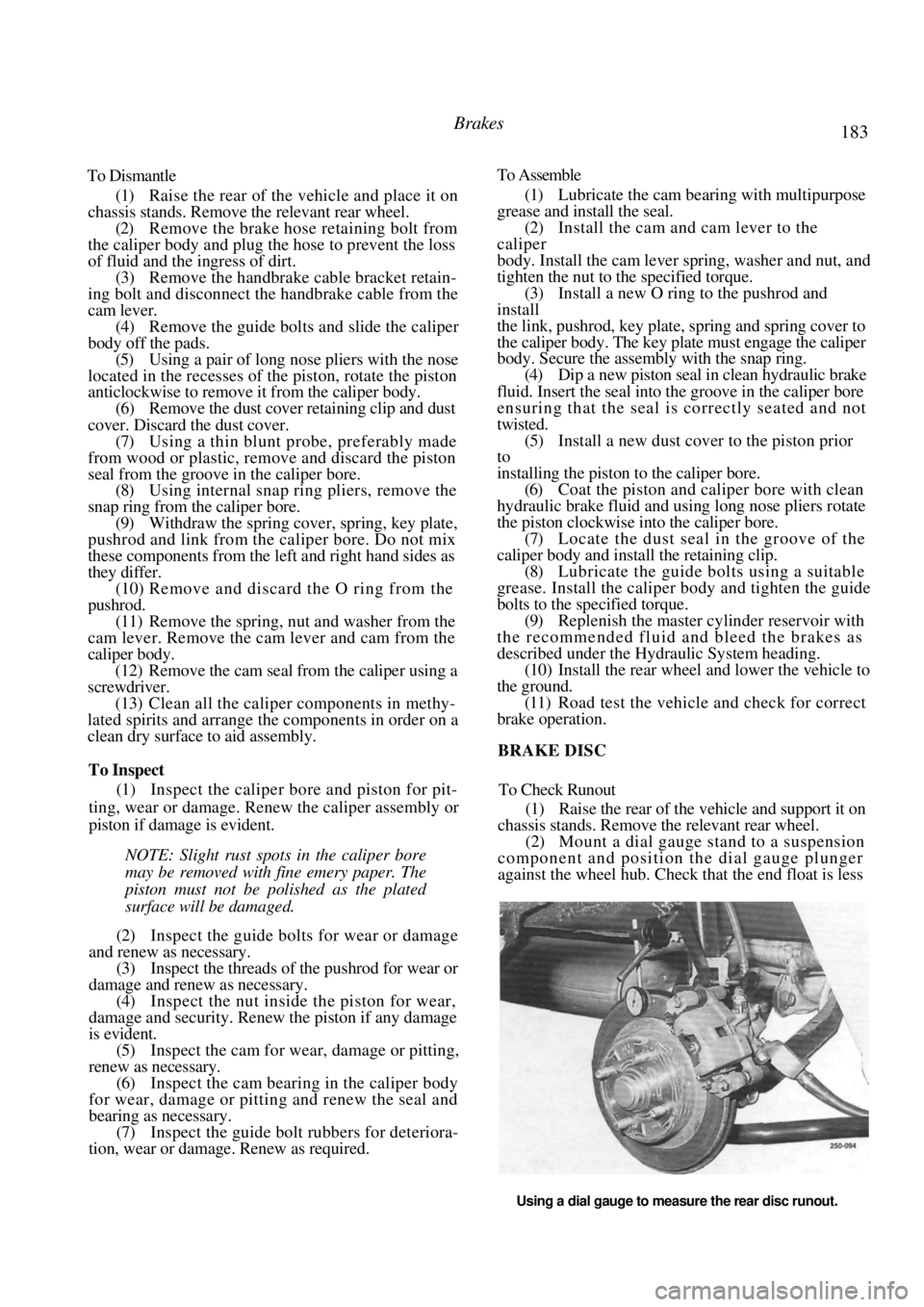
Brakes 183
To Dismantle
(1) Raise the rear of the vehicle and place it on
chassis stands. Remove the relevant rear wheel.
(2) Remove the brake hose retaining bolt from
the caliper body and plug the hose to prevent the loss
of fluid and the ingress of dirt. (3) Remove the handbrake cable bracket retain-
ing bolt and disconnect the handbrake cable from the
cam lever.
(4) Remove the guide bolts and slide the caliper
body off the pads. (5) Using a pair of long nose pliers with the nose
located in the recesses of the piston, rotate the piston
anticlockwise to remove it from the caliper body.
(6) Remove the dust cover retaining clip and dust
cover. Discard the dust cover. (7) Using a thin blunt probe, preferably made
from wood or plastic, remove and discard the piston
seal from the groove in the caliper bore. (8) Using internal snap ring pliers, remove the
snap ring from the caliper bore. (9) Withdraw the spring cover, spring, key plate,
pushrod and link from the caliper bore. Do not mix
these components from the left and right hand sides as
they differ. (10) Remove and discard the O ring from the
pushrod. (11) Remove the spring, nut and washer from the
cam lever. Remove the cam lever and cam from the
caliper body. (12) Remove the cam seal from the caliper using a
screwdriver.
(13) Clean all the caliper components in methy-
lated spirits and arrange the components in order on a
clean dry surface to aid assembly.
To Inspect
(1) Inspect the caliper bore and piston for pit-
ting, wear or damage. Renew the caliper assembly or
piston if damage is evident.
NOTE: Slight rust spots in the caliper bore
may be removed with fine emery paper. The
piston must not be polished as the plated
surface will be damaged.
(2) Inspect the guide bolts for wear or damage
and renew as necessary.
(3) Inspect the threads of the pushrod for wear or
damage and renew as necessary. (4) Inspect the nut inside the piston for wear,
damage and security. Renew the piston if any damage
is evident. (5) Inspect the cam for wear, damage or pitting,
renew as necessary. (6) Inspect the cam bearing in the caliper body
for wear, damage or pitting and renew the seal and
bearing as necessary. (7) Inspect the guide bolt rubbers for deteriora-
tion, wear or damage. Renew as required. To Assemble
(1)
Lubricate the cam bearing with multipurpose
grease and install the seal. (2) Install the cam and cam lever to the
caliper
body. Install the cam lever spring, washer and nut, and
tighten the nut to the specified torque. (3) Install a new O ring to the pushrod and
install
the link, pushrod, key plate, spring and spring cover to
the caliper body. The key plate must engage the caliper
body. Secure the assembly with the snap ring. (4) Dip a new piston seal in clean hydraulic brake
fluid. Insert the seal into the groove in the caliper bore
ensuring that the seal is correctly seated and not
twisted. (5) Install a new dust cover to the piston prior
to
installing the piston to the caliper bore.
(6) Coat the piston and caliper bore with clean
hydraulic brake fluid and using long nose pliers rotate
the piston clockwise into the caliper bore. (7) Locate the dust seal in the groove of the
caliper body and install the retaining clip.
(8) Lubricate the guide bolts using a suitable
grease. Install the caliper body and tighten the guide
bolts to the specified torque. (9) Replenish the master cylinder reservoir with
the recommended fluid and bleed the brakes as
described under the Hydraulic System heading. (10) Install the rear wheel and lower the vehicle to
the ground. (11) Road test the vehicle and check for correct
brake operation.
BRAKE DISC
To Check Runout
(1) Raise the rear of the vehicle and support it on
chassis stands. Remove the relevant rear wheel.
(2) Mount a dial gauge stand to a suspension
component and position the dial gauge plunger
against the wheel hub. Check that the end float is less
Using a dial gauge to measure the rear disc runout.
Page 192 of 238
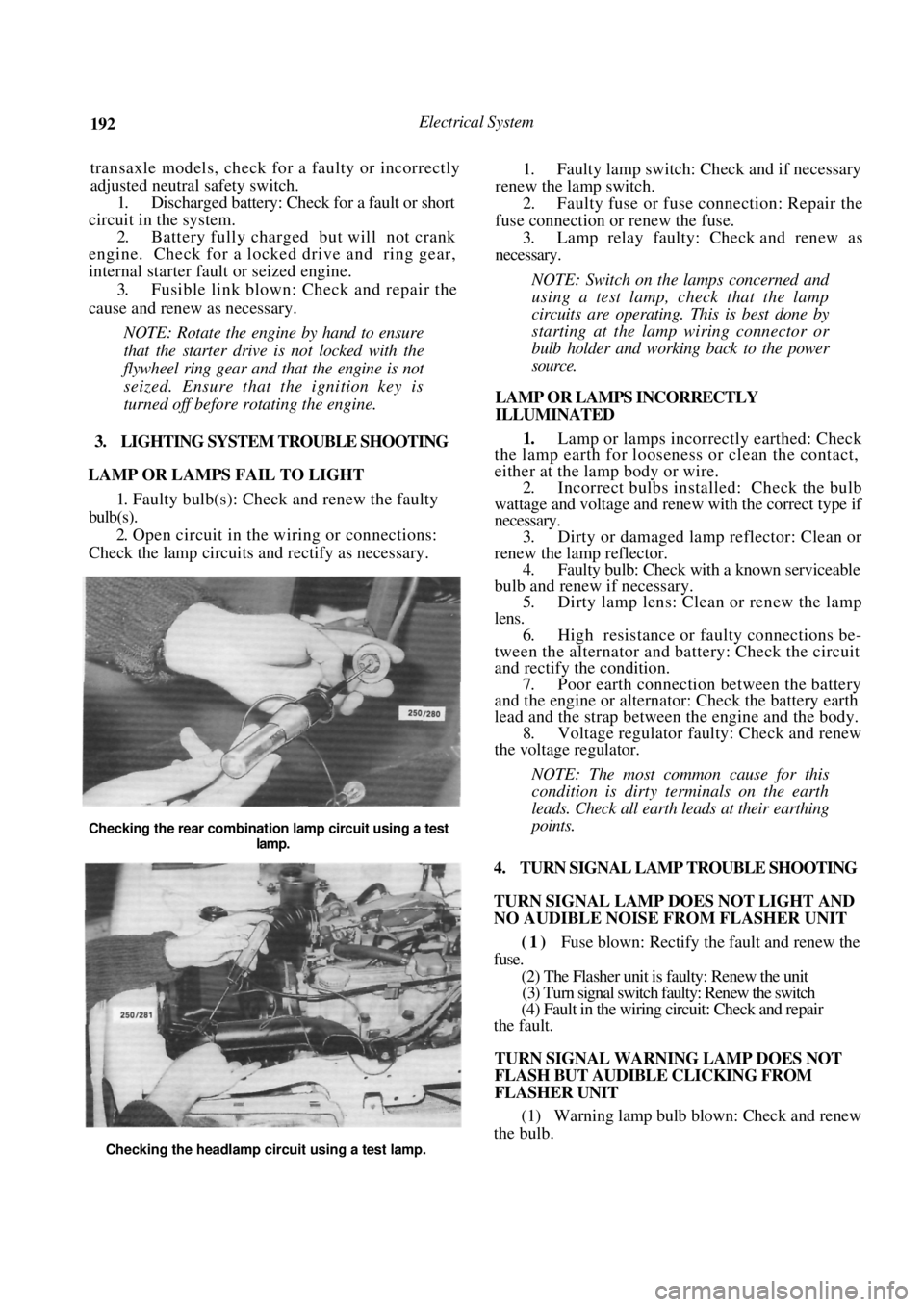
192 Electrical System
transaxle models, check for a faulty or incorrectly
adjusted neutral safety switch.
1. Discharged battery: Check for a fault or short
circuit in the system. 2. Battery fully charged but will not crank
engine. Check for a locked drive and ring gear,
internal starter faul t or seized engine.
3. Fusible link blown: Check and repair the
cause and renew as necessary.
NOTE: Rotate the engine by hand to ensure
that the starter drive is not locked with the
flywheel ring gear and t hat the engine is not
seized. Ensure that the ignition key is
turned off before rotating the engine.
3. LIGHTING SYSTEM TROUBLE SHOOTING
LAMP OR LAMPS FAIL TO LIGHT
1. Faulty bulb(s): Check and renew the faulty
bulb(s). 2. Open circuit in the wiring or connections:
Check the lamp circuits and rectify as necessary.
1. Faulty lamp switch: Check and if necessary
renew the lamp switch. 2. Faulty fuse or fuse connection: Repair the
fuse connection or renew the fuse. 3. Lamp relay faulty: Check and renew as
necessary.
NOTE: Switch on the lamps concerned and
using a test lamp, check that the lamp
circuits are operating. This is best done by
starting at the lamp wiring connector or
bulb holder and work ing back to the power
source.
LAMP OR LAMPS INCORRECTLY
ILLUMINATED
1. Lamp or lamps incorrectly earthed: Check
the lamp earth for loosene ss or clean the contact,
either at the lamp body or wire.
2. Incorrect bulbs installe d: Check the bulb
wattage and voltage and renew with the correct type if
necessary. 3. Dirty or damaged lamp reflector: Clean or
renew the lamp reflector. 4. Faulty bulb: Check with a known serviceable
bulb and renew if necessary. 5. Dirty lamp lens: Clean or renew the lamp
lens. 6. High resistance or faulty connections be-
tween the alternator and battery: Check the circuit
and rectify th e condition.
7. Poor earth connection between the battery
and the engine or alternat or: Check the battery earth
lead and the strap between the engine and the body. 8. Voltage regulator faulty: Check and renew
the voltage regulator.
NOTE: The most common cause for this
condition is dirty t erminals on the earth
leads. Check all earth leads at their earthing
points.
4. TURN SIGNAL LAMP TROUBLE SHOOTING
TURN SIGNAL LAMP DOES NOT LIGHT AND
NO AUDIBLE NOISE FROM FLASHER UNIT
(1) Fuse blown: Rectify the fault and renew the
fuse.
(2) The Flasher unit is faulty: Renew the unit
(3) Turn signal switch faulty: Renew the switch
(4) Fault in the wiring circuit: Check and repair
the fault.
TURN SIGNAL WARNING LAMP DOES NOT
FLASH BUT AUDIBLE CLICKING FROM
FLASHER UNIT
(1) Warning lamp bulb blown: Check and renew
the bulb.
Checking the rear combination lamp circuit using a test
lamp.
Checking the headlamp circuit using a test lamp.
Page 193 of 238
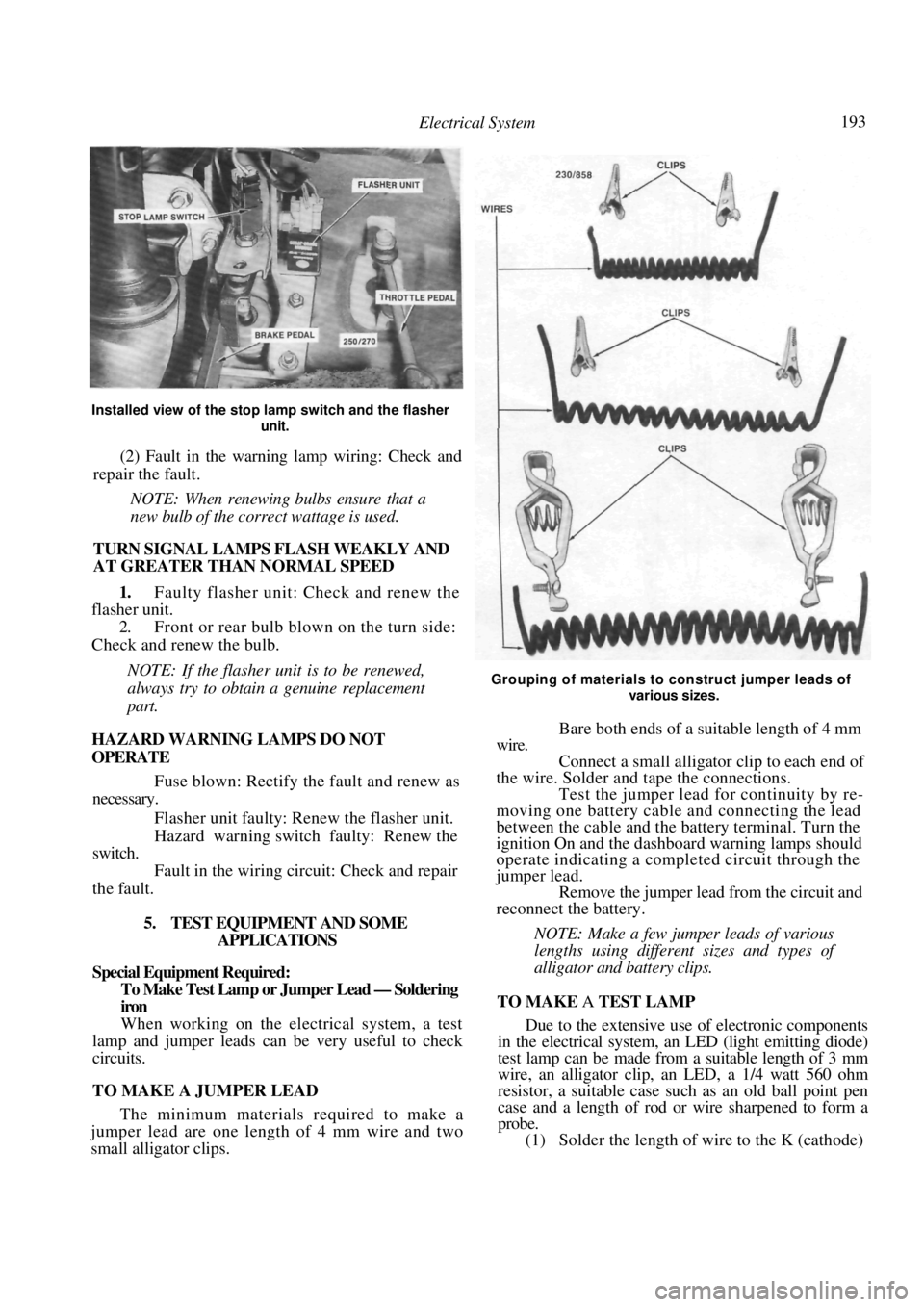
Electrical System 193
Installed view of the stop lamp switch and the flasher
unit.
(2) Fault in the warning lamp wiring: Check and
repair the fault.
NOTE: When renewing bulbs ensure that a
new bulb of the correct wattage is used.
TURN SIGNAL LAMPS FLASH WEAKLY AND
AT GREATER THAN NORMAL SPEED
1. Faulty flasher unit: Check and renew the
flasher unit.
2. Front or rear bulb blown on the turn side:
Check and renew the bulb.
NOTE: If the flasher unit is to be renewed,
always try to obtain a genuine replacement
part.
HAZARD WARNING LAMPS DO NOT
OPERATE
Fuse blown: Rectify the fault and renew as
necessary.
Flasher unit faulty: Re new the flasher unit.
Hazard warning switch faulty: Renew the
switch.
Fault in the wiring circuit: Check and repair
the fault.
5. TEST EQUIPMENT AND SOME APPLICATIONS
Special Equipment Required:
To Make Test Lamp or Jumper Lead — Soldering
iron
When working on the electrical system, a test
lamp and jumper leads can be very useful to check
circuits.
TO MAKE A JUMPER LEAD
The minimum materials required to make a
jumper lead are one length of 4 mm wire and two
small alligator clips.
Grouping of materials to construct jumper leads of
various sizes.
Bare both ends of a suitable length of 4 mm
wire. Connect a small alligato r clip to each end of
the wire. Solder and tape the connections. Test the jumper lead for continuity by re-
moving one battery cable and connecting the lead
between the cable and the battery terminal. Turn the
ignition On and the dashboard warning lamps should
operate indicating a completed circuit through the
jumper lead. Remove the jumper lead from the circuit and
reconnect the battery.
NOTE: Make a few jumper leads of various
lengths using different sizes and types of
alligator and battery clips.
TO MAKE A TEST LAMP
Due to the extensive use of electronic components
in the electrical system, an LED (light emitting diode)
test lamp can be made from a suitable length of 3 mm
wire, an alligator clip, an LED, a 1/4 watt 560 ohm
resistor, a suitable case such as an old ball point pen
case and a length of rod or wire sharpened to form a
probe.
(1) Solder the length of wire to the K (cathode)